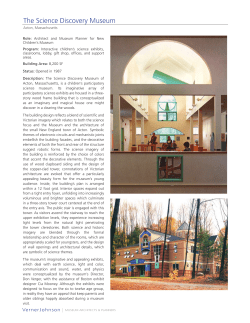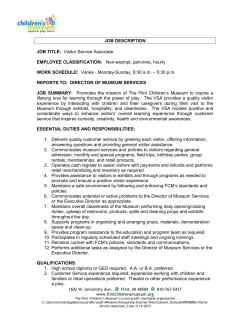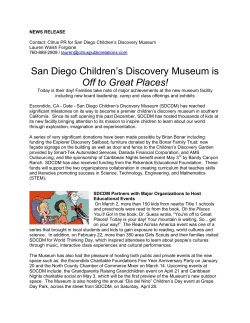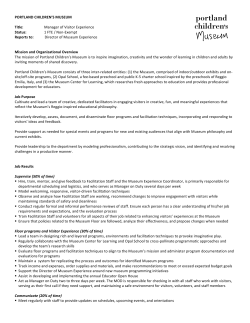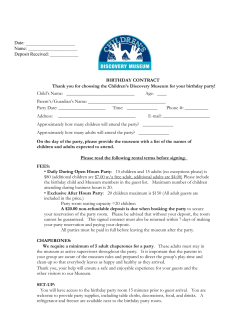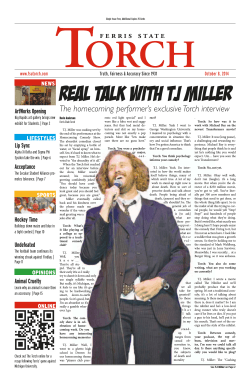
Office Use Only MGFY13 Berghoef Grant Application Cover Sheet
Office Use Only MGFY13 Berghoef Exceptional Merit Grants Program for Faculty and Staff Grant Application Cover Sheet Contact Information for the Primary Person submitting the Proposal: Name and Title: Michael Berghoef, Professor of Social Work Department: Social Sciences Address: 820 Campus Dr, ASC 2104 City/State/ZIP: Big Rapids, MI 49307 Phone Number: 616-485-7331 Email: berghoem@ferris.edu Project Name: A Virtual Museum Collaboration with FSU’s Academic Service Learning Partner in El Salvador Purpose of the Grant Development of a virtual museum commemorating the struggle and resilience of the Santa Marta community Amount Requested: $4725 Total Project Cost: $4725 Dates of the Project: 5/1/13 – 4/1/14 Project Completion Date: 4/1/14 Approval and signatures: The Foundation Office will forward your application to the names you enter below. It will be your responsibility to follow up to ensure the proper signatures are obtained and the completed cover sheet is returned to the Foundation Office. Faculty -- Dean and Department Head Support. The project proposal in the attached document is consistent with the needs and direction of the department and college. Enter the name of your Dean and Department Head/Chair below. Dean: Rick Kurtz Signature, Dean Department Head/Chair: Thomas Behler Signature, Department Head/Chair STAFF - Vice President and Supervisor support: The project proposal in the attached document is consistent with the needs and direction of the department and unit. Enter the name of your Vice President and Supervisor below. Vice President: Signature, Vice President Supervisor: Signature, Supervisor Narrative: When completing the narrative portion, please contain discussion to the allowable space on the page. A statement of how the project demonstrates exceptional merit in advancing the mission of Ferris State University. Include how the project compliments and enhances other efforts on campus and how the project compliments and enhances other efforts on campus and how the project will continue in the future. Over the past 5 years, Ferris State University has sent a delegation of students and faculty annually to study abroad throughout El Salvador. One of the ongoing identified needs of one of our community partners there, the village of Santa Marta in the northern mountains of El Salvador just south of Honduras, is the establishment of a memorial museum, much like the Holocaust Museum in the US, but more local and on a much smaller scale. This community was completely destroyed, the victim of the scorched earth policy during their Civil War, and those in the community who survived fled and dispersed to the mountains and to neighboring Honduras. Prior to the end of the war, they returned, organized, and rebuilt their community from the ashes. This Academic Service Learning project would assist the community of Santa Marta in Northern El Salvador to begin to organize this memorial effort by creating a virtual museum as “Phase 1“of this goal. The community of Santa Marta has slowly been trying to build a physical museum in their remote rural mountain community detailing their story of survival and rebuilding after their Civil War. They have been gathering artifacts, artwork and personal testimonies, and also fundraising for many years now. We are hoping to assist them to start this long term project by using the expertise of the FSU Jim Crow Museum experience, and perhaps the emerging Museum Studies program, to begin with a virtual museum. This grant would support the necessary high quality recording equipment, supplies and translation services as well as travel support for the student team leader, BSW senior Katie Boolman from the 2012 FSU delegation, to return to El Salvador with the next study abroad class in May 2013 to assist the faculty leader in collaborating with the local community members who are associated with this project. Through in depth qualitative interviews, multimedia recordings and community artwork we would weave together the beginnings of a virtual museum. This online presence would then be available to promote fundraising for an actual physical museum to be housed in the community of Santa Marta, El Salvador. The virtual museum will enable us take these community narratives and reach out to FSU alumni, current students and other supporters of our FSU/Salvadoran partnership. It will also connect us with many additional collaborators at other US universities who have visited and partnered with this resilient repopulated Central American community. This interdisciplinary initiative represents the intersection of a wide variety of FSU initiatives including the Jim Crow Museum, the emerging Museum Studies program, Academic Service Learning, the Political Engagement Project, our new Latin@ Studies Center, the International Studies Office, the College of Arts & Sciences, the Social Sciences department, the Social Work Program and the Television & Digital Media Production program. Ferris has much expertise to offer in such a project. This will strengthen our ties with this community and set the stage for further collaborations in that country. We also see this project as setting the stage for future student Fulbright opportunities and our initial consultations indicate that this is exactly the type of initiative they would support. As many have noted our founder Woodbridge N. Ferris challenged our faculty, staff, and students to "make the world a better place." and this project will make a substantial contribution in this direction. We hope to help create a virtual museum , and eventually a physical museum, that will function in much the same way that the US Holocaust Memorial Museum and FSU’s Jim Crow Museum offer a pathway to healing historic wounds through education and a greater understanding of history. This project exemplifies the Ferris Core Values of Collaboration with our various internal FSU partners and ASL community partners in Santa Marta, Diversity in our work with the Latin@ communities in Central America, Ethical Community in our efforts to achieve historical understanding, Excellence in our goal of a high quality and highly accessible online museum, Learning in our exposure of students to creative high impact learning activities and Opportunity in this unusual applied international experience where student leaders are engaged with a community very different than their own. A brief description of the project being proposed and the desired outcomes (maximum 1 page). During our two weeks in El Salvador we will be collecting footage of testimonies from survivors of the Salvadoran Civil War .These testimonies, a vital part of the virtual museum, will be vivid and emotionally compelling interviews with community members who have survived the Civil War. We will also collect digital images of many of the artifacts and artworks that the community has collected to remember their past and commemorate those lost during the war. The camera we have requested will be vital to the success of our project. Last year, a group of students including Katie Boolman, took video footage in El Salvador with the hopes of using it to create a video to disseminate to students and supporters of the trip. Upon returning to Ferris State University and working with faculty and students from the media production program we found that none of the collected footage was of high enough quality to use. We recently consulted with professionals in the media production department and identified a camera that will yield professional high quality footage, worthy of the virtual museum. The interviews of community members and community leaders will be conducted by students and the faculty leader. Other examples of media that we hope to incorporate are: memorial songs written about the war and sung by community members, needlepoint work depicting the escape and repopulation of the community, paintings, murals, pottery and written stories. The art supplies will be used to produce a shared physical display of Santa Marta’s story housed both at Ferris State University and in El Salvador; to symbolize our partnership. Art is a critical part of the Salvadoran culture and often used to teach, relay stories, and display historic events. The art supplies will be provided to community members and their children who wish to share their stories through artistic expression. The finished canvases will then be transported back to Ferris State University to be housed in the International Office and the Center for Latin@ Studies. Once returned to Ferris State University we will work with media production students on the editing of our footage into vignettes for the web site and a short film for independent screening. We then will host a celebration night at FSU Center for Latin@ Studies to showcase the artwork and multimedia we have collected. This celebration will also be a night for us to gain further support and promote the project. The virtual museum will serve as a teaching tool and provide student involvement opportunities for years to come. Through the artwork and testimonies in the virtual museum the voices and hearts of the Salvadoran people will be heard and seen. Another unique aspect of this project is the piloting of the new “Raspberry Pi” computer. (http://www.raspberrypi.org/faqs) This is a low cost PC ($35!) that was designed by the Raspberry Pi Foundation to provide low income children with a device to develop their computer skills. (http://www.raspberrypi.org/about) We hope to use this as a communication conduit once we have returned to the US. We will be able to update the community as to our progress and they will be able to provide us feedback and additional content. It is small, durable and inexpensive and we hope to set up and leave 2 of these behind with our collaborators in El Salvador. Desired Outcomes: The Students working on this project will keep a log of the daily activities, thoughts, issues, concerns, and learning that has taken place during the recording of the videos in El Salvador. This log (blog) will serve as documentation to activities completed during the project as well as information to be used during the creation of the video “Creating a Museum”. The purpose of the first video (Creating a Museum) along with the daily log is to allow other students to be involved and show a behind the scenes look at creating this virtual museum. By seeing where the project started students and other interested will be able to follow its natural progression and begin working on the project without starting from the beginning. This video can also be used as teaching tool to show the challenges and struggles one may face with: collecting data, interviewing, working with older adults, language barriers, starting a new project, visiting a different country and other issues that may arise. This can be used in classes learning about the topics above either directly or indirectly. Students from Media Production will be helping edit the footage we collect as well helping create some the video. The museum's objectives are as follows: *Collect and showcase objects, stories, art and testimonies surrounding El Salvador’s Civil War. *An international resource for teaching, education, and research in the class or outside of class *A vehicle for fundraising efforts to further support partnerships and projects between El Salvador and Ferris State University for the benefit of student learning. *To promote the responsibility of knowledge and to encourage student involvement within communities. *Create international learning communities After returning from El Salvador we will partner with the Center for Latin@ Studies to involve their students in aiding with language translation and dissemination. Timeline for project implementation: April 19 - May 17th: In USA *Consult with FSU webmaster Ted Halm about hosting requirements *Consult with the FSU & Kendall Art faculty about best practices for transportable/durable media. *Consult with FSU Media Production Faculty and FSU Multimedia Specialist for proper use and care of equipment *Create and translate media release form for all participants to sign in El Salvador. May 18th- June 1st: In El Salvador *Keep daily log of activities and work. *Collect multimedia resources for the virtual museum. *Conduct and record interviews of testimony. *Provide art supplies and engage community members in painting. *Visit historic sites to collect footage and photographs. June 1 - December 2013: In USA *Work with the media production students on video editing and create a “Making of the Museum” film. *Invite El Salvador Partners to Celebration night via Skype. *Organize celebration night Multi-media Presentation in the Latin@ Studies Center. December 20th 2013 *Progress report will be submitted to the foundation with preliminary web and video resources. *Prepare audio presentation and scholarly article to disseminate to public radio station and/or possible publication. December 20, 2013 to May 1, 2014 *Complete website with audio, video and digital reproductions of artifacts and artwork. May 20th 2014 *2014 Delegation departs for El Salvador, Faculty Leader will implement updates needed to maintain the website. The names and qualifications of all individuals who are substantially responsible for pursuing the proposal's objectives: Michael Berghoef Professor of Social Work Academic Senate President 2007 – 2009 Carnegie Foundation/AASCU Political Engagement Scholar Developer and Faculty Leader of FSU’s El Salvador Study Abroad course over the past 5 years. berghoem@ferris.edu & Katie Boolman Ferris Senior, BSW Candidate, Phi Alpha Honors Society member and past president FSU Summer Student Research Fellow - summer 2012 Student Leader in FSU’s 2012 El Salvador delegation Student Project Leader for Santa Marta Museum project boolmak@ferris.edu Dissemination Discuss how you will disseminate the results/findings of your project to the University, community, and/or your greater academic/ professional community. Dissemination plans should also be included in your project timeline on page 4. Additionally, identify your specific plans to report to the Foundation Board of Directors your project results and conclusions (per the RFP requirements). The end result of “Phase 1” of this project, the virtual version of the Santa Marta Museum, has dissemination as one of its main goals. It is primarily a “dissemination project”. The resulting web site, short film(s) and other media will be made available to all of the FSU stakeholders as well as those outside of our university who are partners with Santa Marta via the Internet. We hope to partner extensively with the Latin@ Studies Center and the Office of International Education to screen our results. This unique historical memory initiative reflects many of the goals and aspirations of the College of Arts and Sciences, Department of Social Sciences and the Social Work Program. With support and enthusiasm from the Dean of Arts and Sciences and the Social Sciences Department Head it is our hope that this project will be the first step in laying the groundwork for a virtual museum supported by the College of Arts and Science and maintained Social Work initiative. In developing the web presence for this museum we create a powerful teaching tool and provide opportunities for current and future students to engage in high impact educational experiences. With this ongoing study abroad program in El Salvador the faculty leader (Professor Michael Berghoef) will be able to oversee and facilitate updates and additions to the virtual museum, ensuring its maintenance and encouraging continued student involvement. The equipment used in the initial phase of this project will remain in the College of Arts in Science to be used to benefit future efforts on this project and research conducted by faculty and students to further develop of this virtual museum. The project team will work with Dean Kurtz of Arts & Sciences and FSU Web-master Ted Halm to determine the most advantageous and sustainable way to house the resources generated for the online portion of this museum. . We hope that this project will continue to inspire further work, perhaps in the form of faculty and student Fulbright grants and further dissemination at professional regional, national and perhaps international conferences. Indeed our student leader Katie is already laying some of the groundwork to make these aspects a reality. We hope that this project can unite supporters of this endeavor and enable the Santa Marta community to successfully raise funds to complete their vision of the physical museum in their community. A web presence can facilitate this in a way that continued serial visits to the community cannot. By reminding supporters of this project we believe that we can create the necessary critical mass necessary to generate sufficient donations to enter the next phases of development. Budget - Detail how grant funds will be used. The budget should also describe the extent to which any additional resources beyond the Foundation's grant are needed and have been committed to the project. If requesting equipment, assess distribution/disposal upon completion of project. Please list items under the expense categories. **Food and beverage expenses will not be funded by the Foundation. It is not the intent of the grant to fund/provide direct compensation for faculty/staff. Student salaries are considered on a case by case basis** Project Income: Ferris Foundation: 4,725 Department/College: In-Kind (please specify): Other Sources (please specify): Total Project Expenses: Salaries/Personnel Costs Ferris Foundation Department/College Other Sources In-Kind Subtotal 0 0 Supplies and Materials 100 100 Equipment 100 100 1,800 1,800 400 400 175 175 700 700 300 300 500 500 Travel & Transportation Other TOTAL 4,725 Budget Narrative Explain estimated income and expenses listed on the previous page. For ongoing projects, please include a discussion financial sustainability of the project or initiative. “Raspberry Pis” to facilitate continued communication after we have left El Salvador: $50.00 each (including shipping) x 2= $100.00 Peripherals for two Raspberry Pis (Mice, keyboards, memory cards): $100.00 Flip cam Canon XA10 HD Professional Camcorder: $1,800.00 Clipable wireless Lavalier microphone system with receiver for walking interviews and tours of historic sites: $150.00 each x 2= $300.00 Flip Cam Ultra HD back up / 2nd camera $150 External microphone for picking up surround sounds (rain, footsteps, birds, animals, etc.): $100.00 Light kit for filming in dark areas such as clandestine hospitals: $50.00 Charger for the camera use in rural areas : $25.00 Camera bag for safe storage and transportation of the camera: $75.00 Output cable to hook up microphones to camera : $25.00 Camera tripod for stability to increase the quality of the video: $149.00 Airfare for student project leader (Katie Boolman): $700.00 Translation services to enable us to interview individuals and accurately translate interviewee responses: $500.00 Transportation money to and from historic sites in El Salvador - $300.00 Art supplies to provide to people to create paintings/drawings for the museum. Remaining supplies will be used for other Academic Service Learning sites or left with the community. Acrylic paint, two sets of 48 colors, 5 sets of primary colors: $200.00 Posters and canvas: $250.00 Paint Brushes: $50.00 Total $4,725.00 The $100.00 Raspberry Pis are extremely low cost computers with Internet and graphics capability, designed in an initiative by a British Foundation to get computers into the hands of low income people who otherwise would not have the opportunity to work with technology, learn programming or access the world wide web. These will be taken to El Salvador and left in the community on the mountain to enable communication and information sharing after we return to the US. The $100.00 for Peripherals for the Raspberry Pis includes mice, keyboards, and memory cards that will make the Raspberry Pi and fully functioning computer that can use an old monitor or even a television for the display screen. $1, 800.00 Flip Cam Canon XA10 HD Professional Camcorder: A professional camera that will produce high definition footage of the interviews. While we initially balked at this price, our FSU technology consultants strongly recommended this level of camera for this kind of work. The supporting peripherals and storage were recommended to get the proper performance out of this professional grade camera and protect it from damage. $300.00 Two Clipable Wireless Lavalier Microphone: These microphones clip to the interviewers and interviewees shirt. This equipment will allow us to capture the multiple interviewees in different locations. Airfare for the student leader will help offset some of the cost of her return trip to El Salvador in this formal leadership role. She will cover the remaining study abroad trip expenses. $500 will be used to provide translation services both at the time of interviews and during production. $300 will cover the in-country trip expenses of traveling to the various sites from our base in the capital of San Salvador. The art supplies are for the community elders and children to create works that can be shared by the village and FSU as a symbol of our partnership. Salvadoran culture is infused with this kind of artistic commemoration. Upon our return, the recording equipment will be housed in the College of Arts & Sciences for future iterations or similar A&S projects. The Ferris community regularly contributes a considerable amount of donations to this study abroad trip, as do faculty through donations and scholarships. While we cannot quantify that precise amount this early in the process it is usually between $3000 $4000 in scholarships, school / art supplies, computer equipment and medicines. The Academic Service Learning initiative also supports us financially with other projects up to $500 for our work in the nursing home and schools. Submit by Email Print Form
© Copyright 2025


